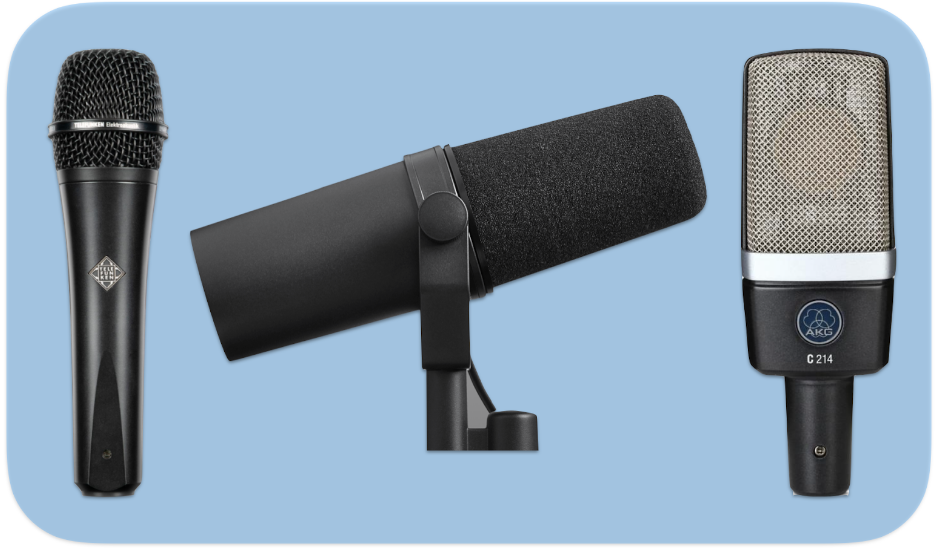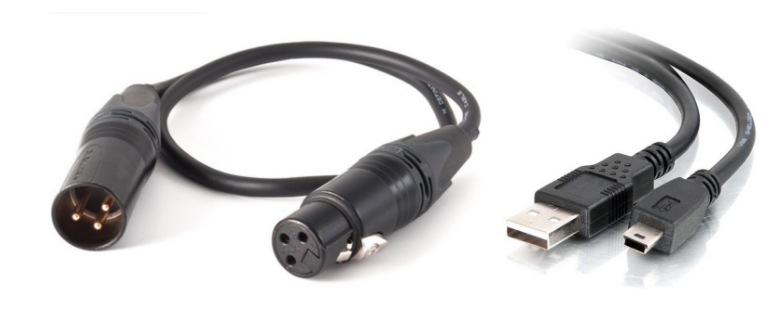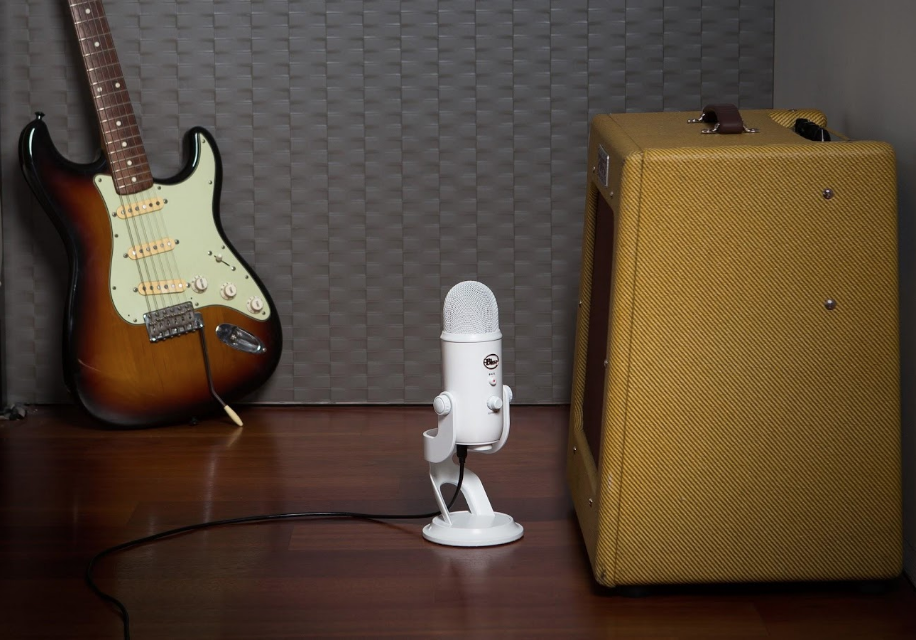The following blog was produced by Sonarworks in collaboration with MI. The author Adam Kagan is an instructor in the Audio Engineering program, and in this blog, he gives guidance on how to choose your first microphone as a creator.
When shopping for your first microphone, you want one that can be used for vocals and all kinds of musical instruments. Eventually, you’ll grow your mic collection to include many different mics, but for now, let’s find one that covers a lot of bases. Many low-cost microphones designed for podcasting, video calls, and vlogging also fit the bill for musicians, but for serious recording or stage work, you will eventually want to invest in professional tools.
Basic Types of Microphones (Dynamic vs. Condenser)
There are two families of microphones: dynamic and condenser mics. Dynamic mics do not require any other power source. They are rugged and can handle loud sound sources. Condenser microphones require a power source. They are more sensitive to softer sounds, and they are more fragile than dynamics. Dynamic mics are found in live situations where durability and ruggedness are required, while condensers are often used in the more controlled studio environment. Both types of mics produce excellent results and you shouldn’t pick a mic solely based on whether it is a dynamic or a condenser type.


Blog Post
"*" indicates required fields
By submitting this form, I authorize Musicians Institute (MI) to make or allow the placement of calls, emails, and texts to me at the phone number that I have provided, including through the use of automated technology, or a prerecorded or artificial voice. I understand that I am not required to provide my phone number as a condition of purchasing any property, goods, or services. I agree to the terms of MI’s Privacy Policy. MI will not sell or rent your information to third parties, and you may unsubscribe at any time.
(L-R) Telefunken M80 (dynamic), Shure SM7b (dynamic),and AKG C214 (condenser)
XLR vs. USB Mics
On stage and in the studio, XLR mics are the standard, and USB mics are not suitable. For your home studio, a mic with a USB connection may be appropriate, offering simplicity, lots of features, and excellent sound capture. USB mics will work well for recording vocals and many instruments, but they won’t do well with really loud or soft sources. USB mics will not work for stage use or for recording sessions that require more than one mic.

Standard XLR mic cable (left) and USB-A to mini USB cable (right)
USB microphones plug directly into your computer, phone, or tablet, while XLR microphones need to be plugged into an audio interface or mixer that then connects to your computer. USB mics often provide features not found on XLR mics, like built-in SD cards for recording on-the-go and built-in noise reduction. Pro audio manufacturers and consumer electronics companies produce USB mics and you can expect to spend between $75 and $300 for a quality USB mic.
USB Mic Pros:
- No need for an audio interface just connect the mic directly to your computer.
- Excellent audio quality, especially for speech recording.
- Many USB mics have built-in stands or tripods.
USB Mic Cons:
- Won’t record extremely quiet or extremely loud sounds well.
- USB mics usually limit your use to one microphone at a time.
- USB mics can’t be taken out for live performances or large studio sessions.
- Construction quality and durability may be poor with consumer-priced microphones.

The Yeti from Blue Microphones is a full-featured USB mic.
Entry-level XLR Mics [$50 – $400]
Great-sounding microphones don’t need to be expensive— the standard live vocal mic (Shure SM58) costs $99. Dynamic mics dominate this price range, providing excellent durability and great sound on everything from voice to drums. They capture sound directly in front of them and reject sounds from other directions, like stage bleed in live sound and household noises during home recording sessions.
Condenser mics provide more features than dynamic mics, like bass roll-off filters, switchable pickup patterns, and pads to avoid overloading the mic with loud sources. Excellent condensers sell for $400 or less, but condenser mics that cost less than $200 are not built to last. Condenser microphones are powered through the standard mic cable, so make sure your interface or mixer can provide 48-volt phantom power.
Pros:
- Dynamic microphones are rugged and durable and provide excellent rejection of unwanted sounds.
- Inexpensive mics allow you to own more than one microphone option.
- Dynamic microphones and inexpensive condensers are used all the time in pro setups, so what you buy now will stay in your collection forever.
Cons:
- These mics, as opposed to USB mics, require an audio interface or mixer.
- Inexpensive condenser mics may sacrifice quality to meet a price point.
- XLR mics require a mic cable and a mic stand.
Mics to Consider for Your Locker
So far we have described the most affordable, professional microphones. If your budget allows, and if you feel you have outgrown your entry-level mic, there are many excellent microphones that cost from $500 to several thousand dollars. Below are some of the more popular microphone options in each price range. Hundreds of companies produce excellent microphones so this list is just a sampling of what is commonly available from typical retail music stores.
USB mics:
Audio-Technica 2020USB – A well-built USB version of Audio-Technica’s versatile AT2020.
Blue Yeti – A favorite for podcasting and audiobook recording.
Shure MV7 – The USB version of Shure’s venerable SM7B broadcast and vocal mic.
Rode Podcaster – An excellent-sounding affordable mic for voice.
Low-cost dynamic mics:
Shure SM57 and SM58 – Legendary studio and stage microphones for voice and everything else.
Telefunken M80 and M81 – High-performance studio and stage dynamic mics
Electro-Voice RE320 – Industry-standard mic for voice and instruments.
Low-cost condenser mics:
Rode NT1-A or NT100 – Well-built, versatile, modern condenser mics.
Audio-Technica 4040 – Above-average performance at an exceptional price.
AKG C214 – The affordable little brother to the legendary AKG C414.
Beyond Entry-Level but affordable:
Neumann TLM103 – Modern vocal standard.
Telefunken TF11 – Lower-cost alternative to the legendary (and pricey) C12 tube mic.
AKG C414 – Legendary all-around mic. Available as XLS (neutral tone) and XLII (brighter tone).
Blue Microphone Bottle Rocket – Affordable class-A solid-state mic with many capsule options.
JZ Vintage 67 – Extremely clean and neutral sounding with a modern design.
Royer 121 (ribbon) – The modern standard studio ribbon. Works on everything.

